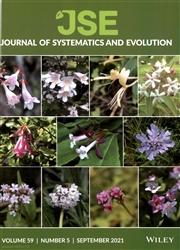油茶科植物和次生代谢物多样化背后的异源多倍体化事件和巨大的古基因组洗牌
IF 2.9
1区 生物学
Q1 Agricultural and Biological Sciences
引用次数: 0
摘要
油茶科(Oleaceae)是一个物种多样性极高的裸子植物科,因其包含许多具有重要经济、药用和观赏价值的植物而备受植物学家的关注。然而,油茶科多倍体化和祖先基因组重组的历史仍不清楚。在此,我们阐明了发生在距今约 5,300 万年前至 6,100 万年前的油茶科常见六倍化(OCH)事件和发生在距今约 1,800 万年前至 2,100 万年前的油茶科新近四倍化(ORT)事件,前者是所有油茶科植物所共有的,后者则是信天翁、油茶、桂花和梣树等品系所共有的。我们发现,高频率的多倍体化事件提高了油橄榄科基因组中基因缺失的频率,并扩大了包含相邻基因缺失区域的大小,从而提高了基因组的破碎程度。我们发现,OCH和ORT产生的亚基因组之间的偏向分化可能是由于OCH和ORT事件中的异源多倍体化造成的。重要的是,通过古染色体重排比较,我们提出了OCH的 "两步 "基因组复制模型,并确定了OCH三倍基因组的复制顺序。我们重建了最近的油茶科祖先核型(AOK)的11条原染色体,阐明了油茶科物种从祖先桉树核型开始的巨大古染色体重组轨迹。值得注意的是,我们追踪了油茶科次生代谢物合成基因的多样化历史,并探讨了古基因组进化对特化代谢物合成的影响。我们的发现为油茶科植物的多倍体化和古基因组进化提供了新的视角,对于理解油茶科植物物种和次生代谢多样性的遗传基础具有重要的科学意义。本文章由计算机程序翻译,如有差异,请以英文原文为准。
Allopolyploidization events and immense paleogenome reshuffling underlying the diversification of plants and secondary metabolites in Oleaceae
Oleaceae, a eudicot family with great species diversity, has attracted much attention from botanists because it contains many plants with important economic, medicinal, and ornamental values. However, the history of polyploidization and ancestral genome reshuffling of Oleaceae remains unclear. Here, we clarified an Oleaceae‐common hexaploidization (OCH) event occurring at ~53–61 million years ago (Ma) common in all Oleaceae plants and an Oleaceae‐recent tetraploidization (ORT) event occurring at ~18–21 Ma shared by the lineages of Syringa , Olea , Osmanthus , and Fraxinus . We found that high‐frequency polyploidization events drove the frequency of gene loss in Oleaceae genomes and extended the size of regions containing adjacent gene loss, thereby promoting the degree of genome fragmentation. We revealed that biased fractionation between the OCH‐ and ORT‐produced subgenomes is likely attributed to the origin of allopolyploidization in the OCH and ORT events. Significantly, through paleochromosome rearrangement comparisons, we proposed a "two‐step" genome duplication model for OCH and determined the duplicated orders of OCH tripled genome. We reconstructed 11 protochromosomes of the most recent ancestral Oleaceae karyotype (AOK) and elucidated the trajectories of immense paleochromosome reorganization of Oleaceae species from ancestral eudicot karyotype. Notably, we tracked the diversification history of secondary metabolite synthesis genes in the Oleaceae and explored the effects of paleogenome evolution on specialized metabolite synthesis. Our findings provide new insights into the polyploidization and paleogenomic evolution of Oleaceae and have important scientific significance for understanding the genetic basis of species and secondary metabolic diversity in Oleaceae.
求助全文
通过发布文献求助,成功后即可免费获取论文全文。
去求助
来源期刊

Journal of Systematics and Evolution
Agricultural and Biological Sciences-Ecology, Evolution, Behavior and Systematics
CiteScore
7.40
自引率
8.10%
发文量
1368
审稿时长
6-12 weeks
期刊介绍:
Journal of Systematics and Evolution (JSE, since 2008; formerly Acta Phytotaxonomica Sinica) is a plant-based international journal newly dedicated to the description and understanding of the biological diversity. It covers: description of new taxa, monographic revision, phylogenetics, molecular evolution and genome evolution, evolutionary developmental biology, evolutionary ecology, population biology, conservation biology, biogeography, paleobiology, evolutionary theories, and related subjects.
 求助内容:
求助内容: 应助结果提醒方式:
应助结果提醒方式:


